
One day years ago, when I was out of work and feeling low, my friend Lenny Silverberg was about to teach a six-week, six-hour-a-day summer life study at the California College of Arts and Crafts, and I asked if I could join without paying.
I had by then learned how to contour in pencil from Nicolaides’ The Natural Way to Draw and, after Lenny’s okay, I went to the first class in the carriage house, where a young model reclined on the platform only a few feet from where I sat on my drawing horse. When Lenny saw me struggle with my pencil, he said:
“Why don’t you try charcoal? It may be easier for you.”
“I don’t know how to use charcoal,” I said. I read only the beginning of Nicolaides and not about drawing in mass.
“It’s very easy,” Lenny said. “Here, let me show you.”
Then breaking in half a stick of compressed charcoal and holding it sideways, he formed the curve of the model’s breast as if he were caressing it.
She had full and luscious breasts that glowed in the natural light, and Nicolaides had said the natural way to draw was to feel what you see.
“Here,” Lenny said as he stood up, “you try it.”

So, returning to my drawing horse with the half of the charcoal stick, I too palmed the model’s breast as if feeling it and, when it suddenly appeared on my paper, it was Eureka! (with an exclamation point)!
And the rest is history, as the saying goes, since it was not just a drawing horse I was sitting on, or the kundalini up my spine from the model’s areola, it was the horse in me who would cure my blues. And in the following days the charcoal led to pastels, until I returned for the next six weeks, like a Percival who had just discovered the meaning of the Holy Grail.
Came the Fall I enrolled in an oil painting class at Laney Community College, taught by the late June Steingart (who was my mother’s age). Like a mother she showed me not only how to use a brush and a palette and palette knife, but opened the door to the rest of my life.
Then moving my bed to the side of the kitchen and turning my bedroom into a studio, I lived on the dole until my friend Leo Litwak found me a part-time writing workshop to teach at San Francisco State, and I painted day and night. Until one weekend when I visited my mother, she watched me at my easel in her garage and said sadly in English:
“You turned from one no-money work to another no-money work, and now no woman will want you and you’ll never have a family.”
But there was no turning back. I was now forty-three, yet as if still in puberty with so much to learn, I hurried to work as if pushed by a force that was alien to the wife and family my mother said I wouldn’t have, and I kept painting whether the model was a sexy young woman or an old man with fungal toenails.
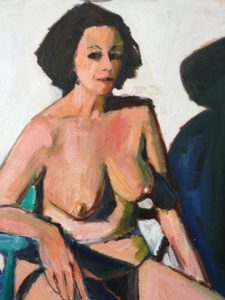
I was of course not just learning the art of painting, but what it meant. I knew what art meant in writing, with the sound and sense of words, and now I would learn it in space and light, while the years passed with models in life-study and still-life in my cottage, until one day a decade later, my painter friend Henry Brandon mentioned painting plein air and I asked if I could join him.
He said he would have to ask his painting partner, Terry St. John, and when Terry said sure, I joined them with my easel and oils in the trunk of my ancient Honda. They were seven years older than I and friends since Berkeley High. They had become painters when Henry studied with Richard Diebenkorn at C.C.A.C. and Terry with James Weeks at the San Francisco Art Institute; yet they didn’t paint plein air until Terry curated the landscapes of Lou Siegrist with The Society of Six at the Oakland Museum.
Lou was around eighty then and Terry would drive him to the hills of Mt. Diablo State Park, and when Lou’s son Lundy came, Terry and Lundy would drive to the other sites around the East Bay that were everywhere then and so scarce nowadays.
“Lou would say landscape painting separates the men from the boys,” quoted Terry when I first arrived on the scene, and it was true. The years of life-study and still-life were my apprenticeship and now I would journey to where the vanishing point opened the horizon to the sky and the light flowered into an infinity of colors.
But it cost money, not only for paint and canvas, but to pay the rent and the mechanic. Terry and Henry had adequate pensions but I would have to live I as cheap as I could, and though I had found the grail in Lenny’s workshop, it vanished as soon as I faced what I was up against.
“Can’t you paint part-time,” my mother said, “and have a family too?”
After surviving the death march and my father’s stroke, she didn’t struggle to raise me so I would be miserable. All right, paint if it makes you happy, she said. I was back in my woman-story of why I never married, while facing what I was up against in art — an even a bigger story.
Terry and Henry did have families whose kids were now grown, but they too faced what every artist was up against. Even back in the caves where facing the wall was as vital as food and shelter. Even Michelangelo himself had to face, in his own cave, what art was really all about.
We painted outside only part of the week and then with models in between, Terry with those he could afford in his studio while Henry and I painted them in different groups. And though we lived our other lives in the meantime, facing a blank canvas was always most important.
We painted under the old Carquinez Bridge in Crockett before the new one was built, and we painted in the old Presidio in San Francisco before it was developed, and in the old Safeway parking lot in Alameda by the estuary until it too was developed, and by the old Armory in Benicia and the old naval base in Marin and the marsh in Martinez where Joe DiMaggio was a boy, until we had to leave there as well, always on the lookout for somewhere else.
But Diablo was our favorite, Terry and Henry with their easels by their pick-ups and I, by my Honda facing the hills and the valley, as the cows ambled to their ranches and the coyotes loped in the distance, the turkey vultures gliding above and the wild grass a blaze of yellow in autumn and a glowing green in spring, the light always visionary in the magic hour as the years passed.

Twelve years after my mother died and Terry moved to Thailand, and after Henry stopped painting outdoors, I painted alone by the cove at the Berkeley Marina and on Second Street by the factories.

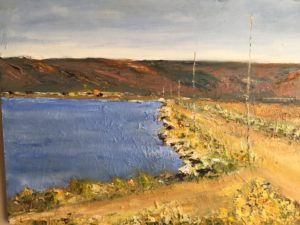
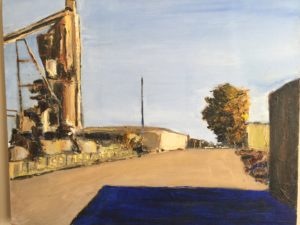
Terry had been painting for fifty years when he moved to Thailand with his new Thai girlfriend, and he had so many paintings by then he had to dump three truckloads. His gallery did store a bunch and he stored others with friends, but there were still three truckloads left over.
Henry’s house and garage were also full when he was moving to Florida to be near his son, and he too thought of dumping them when I said, “Henry, you can afford to store them in Florida. Don’t think of what will happen to them. Just keep painting.”
When my cottage was being sold and I had to move to this bungalow, it had a garage for my own paintings but I too had to stuff stacks of my works on paper in the recycling bins. And who knows what will happen to the rest when I’m gone? Some Tibetan artists shape their mandalas in sand, like children with castles on a beach that the waves will wash away. Even Shakespeare will disappear, said Virginia Woolf in To the Lighthouse. “The artist is one who dares to fail,” wrote Beckett.
Yet “the impulse to draw is as natural as the impulse to speak,” said Nicolaides, and my own impulse began when I penciled a horse on the wall by my bed before I could write. And though I stopped when I began to write, the need to draw that horse again stayed inside me until it surfaced in my middle age, when I wrote a novel about a painter imagining his grandmother whose face his mother couldn’t remember.
The grandmother disappeared on a death march with her son. The son’s character was modeled on my mother’s older brother whom she remembered always drawing, and he must have had some talent since she recalled he drew for the church when they lived in town.
My ancestors lived on their vineyard from spring to when they returned to Adana in the rainy season, where they lived in one room in a tenement, so his drawing must have been in that room and wherever he might draw in the vineyard while helping with the garden and the vines.
Who knows what his peasant life may have been like before my mother never saw him again? I’ll never know him, yet I know his need to draw was the same as in the peasant boyhoods of Giotto and Fra Lippo Lippi and even Arshile Gorky, who was his age and held his mother in his arms when she starved to death. “He loved drawing very much,” was all Degas wanted on his grave, and my uncle’s grave is now somewhere in the rubble between Aleppo and Damascus and the bones in the Syrian desert.
I paint it by the meadow at the Berkeley Marina. I’m as old now as old Lou, who said it separates the men from the boys, yet like the mythical Percival who would never find the grail after losing it, I have to keep searching.
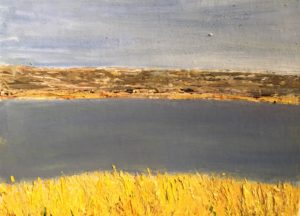
The meadow was where we would dump our rubble at the shore of the bay when I lived with a commune fifty years ago. And after a wilderness flourished from the landfill, a generation of nature lovers and U.C. Berkeley botany students would stroll and study the different flora and fauna, until the Santa Fe railroad sold the property to the state. Thanks to a group started by Silvia McLaughlin, for whom it is now named (as if it is a so-called “habitat restoration project”), the “park” has virtually become a private nursery of a special interest group that includes some members of the local Audubon Society, who have surrounded it with a fence to keep the public out.
I protested with Silvia herself before she died, and I was with her when she said to the new group: “I didn’t work so hard to lock people out.”
But she died, and I now have to paint outside the fence, where her name is by the “Keep Out” sign, the flocks of blackbirds and the hovering kestrels all gone, after the special interest group clear-cut the original wilderness. Sometimes I include the fence in my compositions, since art can include anything, even a concentration camp.
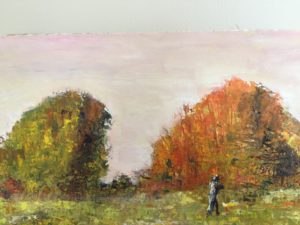
Once again, I stand with my easel facing the earth and sky as if they are my mother and father in the rolling hills and looming clouds, though they are really inside me, as their colors keep changing. Color is light, said Cezanne, but I can never catch its glow, like Apollo failing to rape the Dawn before she hardens into a laurel tree.
I grew up with landscape painting, though I didn’t know until I was grown that it rooted the art of my time when Pollack and deKooning and Kline and Gorky himself were all, in essence, landscape painters descended from Cezanne’s cubes and spheres, where all painting stemmed between an up and a down.
Facing the vanishing point in the horizon between the hills and the meadow, I am what my uncle would have been, while the clouds morph like Zeus in his lust and the hills lie behind the meadow like a nude, all my years of perspective and proportion at play with the luscious oils in memory of Terry with his big pastry spreader knife, spreading his huge canvas in an orgy of colors, while Henry pecked and dabbed in his gluttony for pattern and design.

A passerby stops to chat: “I used to paint,” she says, “but I had to work to raise a family.” She’ll get back into it when she retires; she’s always loved it.
There are millions of her everywhere, but what have I done with my life instead of raising a family? What is the action of my story? The daily news fills with misery and madness, while my painting can’t pay my new rent, and with my annual income only $12,000-a-year, my savings are running out. I’m 78-years-old and my years are running out, too, like the polar bears and the elephants and the planet itself. Where is the grail I lost when I found what I was up against?
My mother was right: I chose a life of no-money work, yet it was with her help. I was her darling who could do whatever I wanted, but I wanted a father and became, like him, a kind of cripple.
I was a healthy child blessed with a great mother, until she had to leave me because of his stroke, and I wandered from her kitchen to a life of loneliness and longing.
The waxing moon rises in a royal blue above the whales of clouds and the meadow glows like the Daphne I can’t catch, the fence my impasse and dead end. Speak, words, in my need to tell my story, like the end of The Horse’s Mouth where a mother nun tells Gulley not to speak because of his stroke — that was like my father’s when I prayed to a God that didn’t exist to make him whole again — the nun telling Gulley he must pray instead of laughing and he says: “Same thing, Mother.”
He was my hero when I moved to Spitalfields near his boat with my portable Underwood instead of a paintbrush. “Artist” meant “painter.” But a writer was also an artist, though twenty years would pass before I could be both, like Gulley’s own hero, Blake.
My need to write was the same as the need for the sky to heal my father like myself and the reason I would never marry and have a family. With my Underwood on a fruit-crate and my stew cooking on a paraffin heater in my Raskolnikov attic, I worked on my first novel about my father and what crippled me.
I had wanted to be an artist since I drew that horse on the wall by my bed and then lost the boat I made in kindergarten when trying to sail it in the sewer beneath the grate by the curb. I dropped the string and it sailed into the underworld like Lawrence’s Ship of Death.
“Artist” meant my longing for the sky and falling in love with Saroyan’s Daring Young Man on the Flying Trapeze who starved to death like the suicides of Martin Eden and Hart Crane whose Voyages ended with the seal’s wide spindrift gaze toward paradise.
So too did I want to die, yet I kept writing as if words would save me, like Piero’s Baptism in The National Gallery in Trafalgar Square, washed clean from my Slough of Despond.
A boy approaches and wants to watch how I butter my sky and meadow with the yellows and blues of my memories. He is my uncle, watching me survey the winter weeds as if they are the history my no-money work.

He is part black and brown and white like the African-American, Hispanic, and Arabic kids I sub in the Oakland public schools.
Where is he from? and he says Berkeley. He’s waiting for his mother who is parked by the road and has gone to the restroom in the Doubletree Hotel. He is the grandchild I never had and, when his mother arrives, she is an attractive woman, wearing earrings like the daughter I never had. And they leave.
The sun is sinking behind the clouds that flame like the apocalypse at the end of Blake’s Jerusalem, only a few minutes left of the golden rays, like the end of my life.
It sinks below the horizon and the clouds darken with deep purples like a bruise so beautiful I want to sink into them and never wake: darker and darker until the darkness swallows them and I must face another night alone, always alone.
Naked in the night we come/ Naked in the night we go/ Come to my arms, naked in the night
Western wind when wilt thou blow/ the small rain down can rain/ Christ if my love were in my arms/ and I in my bed again (anon.)
I can’t paint the night; it would be like trying to paint death: my father dying in a charity ward with his eyes looking at me like pebbles in water; my mother looking at me before she died when I didn’t know if she knew me or not.
Seventy years have I lived/ and never have I danced for joy, wrote Yeats.
There is no joy as long as I am an I. I longed for it since I was a boy, and now I am an old man in a winter’s night, failing again to catch the glow.
Try again, says the ghost of my uncle in the nightmare of history, the artist is one who dares to fail.
Awake, awake, O sleeper in the land of shadows, wake! expand!/ I am in you and you in me, mutual in love divine. (Blake)
